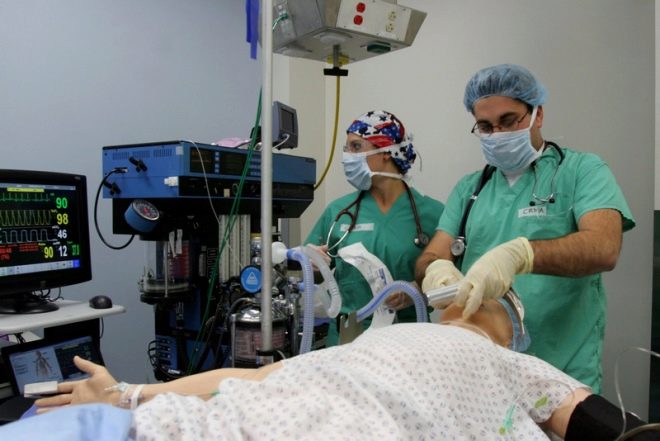General anesthesia for caesarean section
General anesthesia has long been the only type of surgical anesthesia. Caesarean section was no exception. The woman had no choice, but there was also no dispute in favor of this or that type of anesthesia.
Now, when there is a choice between epidural, spinal anesthesia and general anesthesia, women are wondering which way to not feel pain better. In this article we look at the features, advantages and disadvantages of general anesthesia.
What it is?
The popularity of general anesthesia in recent years has decreased markedly. But not because this type of anesthesia is dangerous. In many ways, rumors about his high harm and detrimental consequences for the child are exaggerated.
Just in the first place comes simplicity and security.. A simpler type of anesthesia is considered to be epidural anesthesia, in which anesthetic is injected into the epidural space of the spine, blocking the transmission of nerve impulses from the spinal nerves to the brain.
There is unofficial information that the recommendations of the Ministry of Health on the use of spinal anesthesia are caused by the relatively inexpensive cost of funds for it, while general anesthesia requires more expensive drugs and more complex techniques.
In any case, women who choose general anesthesia for a planned cesarean section encounter an anesthesiologist at the maternity hospital with a complete misunderstanding.
They are trying with all their might to convince them that the operation, while the patient is fully conscious, is exactly what every woman in labor wants. If the patient insists, the doctors are forced to agree, because the choice of the method of anesthesia is the legislative right of the patient herself.
General anesthesia prevents a woman from seeing the touching moment of the birth of a baby.
With a crumb birth, it usually occurs only a few hours later. But even for sensitivity, which can be partially preserved during epidural anesthesia, it is possible not to worry - the woman sleeps well under general anesthesia, does not feel pain.
Most surgeons do not share the optimism of the Russian Ministry of Health regarding spinal anesthesia. Experts claim that it is easier for them to operate a woman who is completely relaxed and unconscious than to make sure that the patient does not hear something extra, does not see what she does not need to see, and fear that she will strain the muscles of the peritoneum, if the blockade was not complete. In addition, the answers to the patient's questions at the time of the operation are also not included in the plans of the surgeon, and under local anesthesia women are usually very sociable.
Most often, general anesthesia for caesarean section is endotrecheal.
How is it done?
Many women who had general anesthesia were completely convinced that they were given intravenous medication, after which they fell asleep. In fact, endotracheal anesthesia is more laborious, but the patient does not usually remember the other stages.
If a decision is made to conduct an operation under general anesthesia, then a woman should be prepared for it in advance. If the operation is planned, then it is recommended to go to the hospital in advance to do all the necessary tests and to undergo premedication.If the operation is performed urgently, then general anesthesia is done automatically, without asking the woman about her preferences. In all cases when you need to deeply anesthetize and quickly remove the baby, endotracheal anesthesia is the only sensible solution.
Preparation includes taking a drug group of barbiturates, usually in pills. Premedication is necessary for a woman to sleep well the night before the operation. Good sleep improves pressure and prevents spontaneous surges.
On the morning of the operation, an enema is performed to clear the intestines, the pubis is shaved, sometimes bandaging with elastic bandages of the lower extremities is recommended to rule out thrombosis.
In the operating room, the patient is injected with a dose of atropine, which should protect her heart from the possible risk of being stopped in deep medical sleep. Then the surgical team begins to prepare for the operation, and the anesthesiologist checks the level of pressure, the pulse and injects an intravenous anesthetic. This drug causes rapid sleep. The rest happens without her participation, because she moves from different stages of medication sleep to the next, and sometimes she dreams and sometimes just temporarily “absent”. It all depends on the depth of anesthesia.
As soon as the doctor is convinced that the patient is fast asleep and does not respond to touch, he inserts a special tube into the trachea of the woman in labor. She will ensure the process of pulmonary respiration during the operation, since the woman herself will not breathe.
The tube in the patient's body begins to receive oxygen, sometimes with an admixture of nitrogen. Sometimes pairs of narcotic drugs are also injected into the inhaled mixture. The tube is connected to the ventilator.
Sometimes doses of drugs dose modern dose meters, which track even the slightest changes in the concentration of a gas and a drug for drip spray.
A woman cannot feel pain. Her sleep is very deep, any sensitivity is excluded completely.
The anesthesiologist is nearby and monitors the condition of the woman every minute. If necessary, it adds a dose of anesthetics and muscle relaxants. There is an established catheter in a woman's vein. If necessary, through it will be introduced any medication that may require the condition of the woman.
Approximately 15 minutes before the end of the operation, the surgeon notifies the anesthesiologist that support can be stopped, and from that moment begins a slow and gradual awakening. The first is the respiratory reflex. This becomes a signal to the anesthesiologist to extract the tube from the trachea. After the operation, the patient is sent to the intensive care unit, where in the next few hours she will have to leave the state of anesthesia under the supervision of doctors.
Advantages and disadvantages
According to the opinions of women and doctors, general anesthesia has several important advantages:
- no contraindications;
- no pain and psychological fear during surgery;
- recovery from anesthesia is 2-3 hours, but the body is finally restored in 3-4 days;
- no backache, no headaches like after epidural.
The disadvantages are possible complications. These include:
- possibility of injury to the tongue and larynx;
- dry cough and sore throat for several days;
- delayed meeting with the baby;
- the possibility of drops in blood pressure and heart problems under general anesthesia;
- slight nausea and dizziness for several days after surgery;
- the child is exposed to temporary effects of drugs, but it passes.
About general anesthesia and other types of anesthesia for caesarean section in the next video tells the specialist anesthesiologist.



















